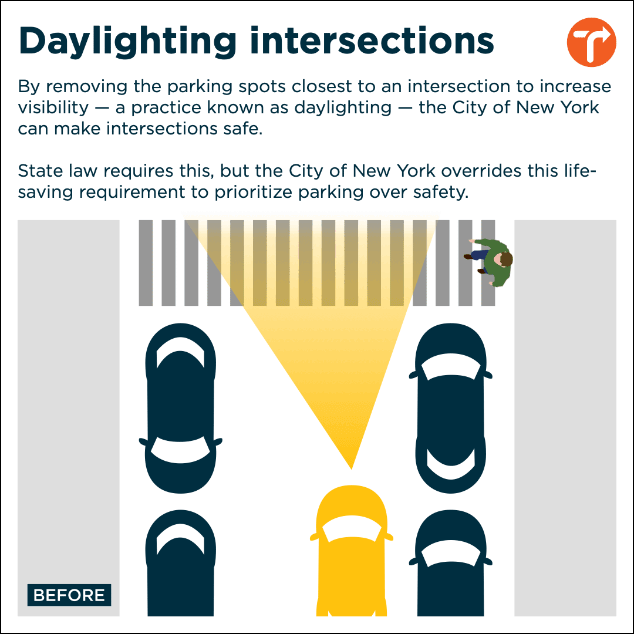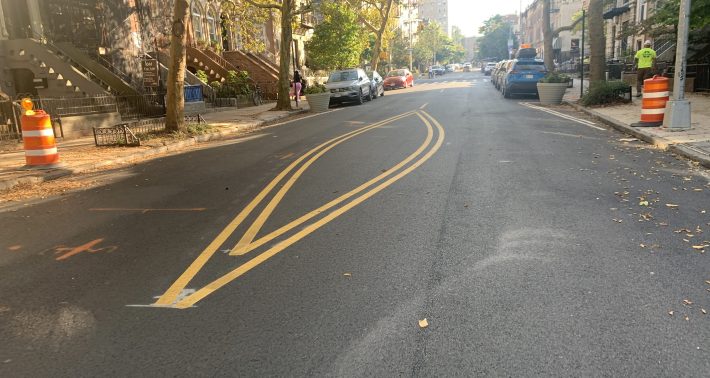No intersections in a Brooklyn neighborhood that's battling the Adams administration for safe streets are clear of parked cars as required under state law — and locals see it as evidence that the area’s streets "really are unsafe.”
According to an on-the-ground survey of all 54 intersections in Prospect Heights, not a single intersection has “full” daylighting — meaning that all four corners bar parking within 20 feet of the corner.
Here's why: New York City exempts itself from state law requiring daylighting — and that's something members of a growing chorus of community boards, plus neighborhood activists, can no longer abide.
“The reality that none of the intersections in Prospect Heights meets state standards has put things in perspective for us — our neighborhood streets really are unsafe,” said Gib Veconi, chairman of the Prospect Heights Neighborhood Development Council, which conducted the block-by-block survey and has been demanding that the Adams administration finish its proposed Underhill Avenue bike boulevard and support continued operation of the open street on Vanderbilt Avenue.

The group said it was "compelled" to undertake the assessment after the recent deaths of Kamari Hughes, the 7-year-old boy who was run over by an NYPD tow truck driver whose view was likely blocked by a parked car, and Yvonne Sandiford, the senior citizen who was hit by two drivers on another dangerous street nearby. After Hughes’s death, Council Member Crystal Hudson called for daylighting all intersections within a half-mile of a school — which would include all 54 intersections in Prospect Heights.
Veconi cheered Hudson's call — and reiterated that City Hall should complete the stalled Underhill Avenue project, which was unceremoniously halted by the Adams administration on the grounds that not enough community outreach had been conducted in the two-plus years that the Department of Transportation was conducting community outreach.

The mayor said his team would be "knocking on doors" to get more feedback, but that turned out to mean a new deployment of street ambassadors as well as another digital survey sent to people who had already been involved in the outreach process (the survey's last day is Wednesday). In addition, the mayor has installed a land-use bureaucrat with no transportation background to intervene in DOT projects on behalf of the mayor's chief advisor, Ingrid Lewis-Martin, an opponent of street safety projects, Streetsblog reported exclusively.
Even the "bike boulevard," however, does not have intersections that are fully compliant with state law, the Prospect Heights group said.
"The bike boulevard is a significant safety improvement, but there is a very long way to go to meet state standards, and we won't get there by delaying projects on Underhill Avenue and Vanderbilt Avenue," the group said in a statement.
The Prospect Heights survey was released on Monday, hours before a Brooklyn man was hit by the drivers of two cars as he crossed 37th Street and Fort Hamilton Parkway in nearby Borough Park. Activists blasted the city for an intersection that "is missing even the most basic safe streets infrastructure."
"The intersection lacks turn calming, daylighting, curb extensions, leading pedestrian intervals, ... re-timed lights to 25 mph, or even sidewalks on both sides of the street," Transportation Alternatives said in a statement.
It's worth taking a moment to explain why city intersections are not routinely daylighted, given that under Section 1202 of state law, it is illegal to park "within 20 feet of a crosswalk at an intersection."
Make that illegal if New York City wants it to be illegal. Under a different part of state law — Section 1642 of the Vehicle and Traffic Law — "cities having a population in excess of one million" (also known as New York City) "may ... supersede the provisions ... where inconsistent or in conflict with respect to ... parking, standing, stopping and backing of vehicles."
It's a power that the city eagerly exploits — as it says in its own traffic code, section 4-02(e): "Pursuant to authority provided by §1642, the following provisions of such law shall not be effective in the City of New York: §1112, 1142(b), 1150, 1151, 1152, 1153, 1156(b), 1157, 1171, 1201, 1202 [the daylighting rule linked above], and 1234."
The good news about some of those exemptions is that they give city pedestrians and cyclists more right of way than are granted them under state law.
The bad news is that the city picks and chooses the corners that it wants to daylight, which it typically does automatically after a fatality, as it did in the case of Kamari and 7-year-old Dolma Naadhun in Queens earlier this year.
The agency has daylighted hundreds of intersections this year — more, even, than the 100-intersection mandate that will kick in in 2025 under a Council law.

But more needs to be done, activists say. So far this year, according to city stats, the have been 180 reported crashes in Prospect Heights, a tiny area bound by Eastern Parkway, Flatbush Avenue, Atlantic Avenue and Washington Avenue. Those crashes have injured 75 people, including 24 cyclists, 18 pedestrians and 33 motorists.
Veconi doesn't want to wait for a fatality.
“The number of Prospect Heights children under 15 increased by 32 percent between 2010 and 2021, and residents over 60 increased by 83 percent," he said. "We hope it won’t take another tragedy for the Mayor to take street safety seriously and complete the projects DOT had slated for this year."
The city is behind on other street safety efforts, as well. Bus and bike lane mileage figures appear to be short of Council-mandated requirements. And even raised crosswalks are allegedly behind schedule:
New Yorkers were promised 100 Raised Crosswalks a year and the City is falling well short of that based on their own data:
— Philip Miatkowski (@miatkowski) November 14, 2023
2022: 24 installations
2023 through 11/6: 23 installationshttps://t.co/ORXJUIwqpS https://t.co/57EdJVFK6R
The DOT did not respond to a Streetsblog request for comment.






